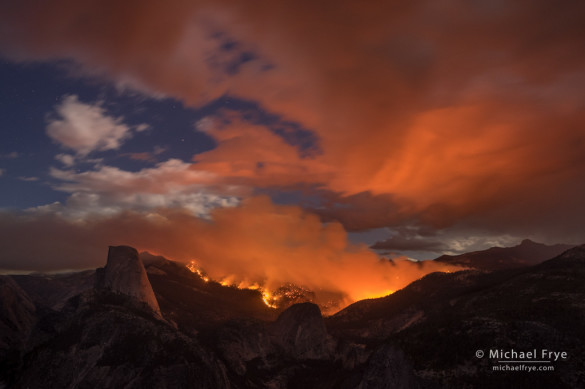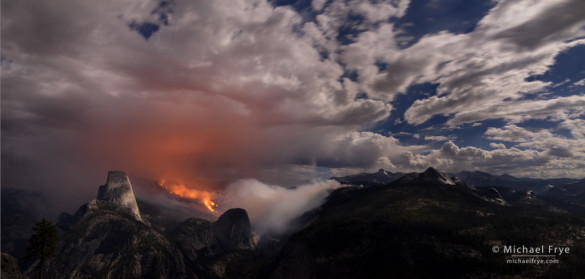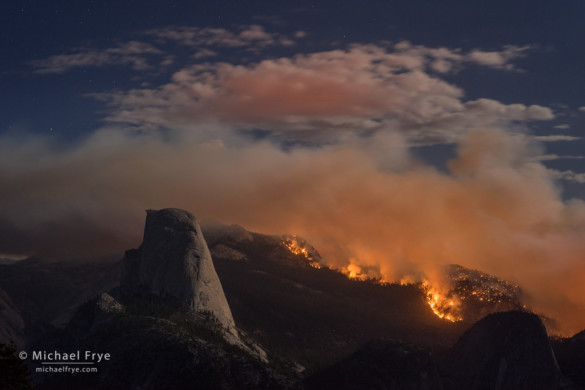
Meadow Fire burning in Little Yosemite Valley at night, with Half Dome on the left, Yosemite; 9-7-14, 8:44 p.m.
Sunday afternoon Claudia and I saw dramatic images on the Yosemite webcams of a fire in Little Yosemite Valley. We’ve had many fires around here the last two summers, and I’ve made plenty of fire photographs. But how often can you photograph a fire next to Half Dome? We decided to head up to Washburn Point (near Glacier Point) to take a look.
The origin of this fire is officially under investigation. The park service has been letting the lightning-caused Meadow Fire burn for awhile, and it’s likely that embers from the Meadow Fire were picked up and blown into an area with heavy fuels, then were fanned by the wind. But it’s also possible that this is a new fire with an unknown cause.
In either case, the winds caused this fire to blow up suddenly Sunday at about 12:30 p.m., closing all the trails in and around Little Yosemite Valley, and forcing the park service to evacuate 50 hikers from the top of Half Dome by helicopter! A big news story, as you can imagine. As of yesterday, the fire was estimated at 2,600 acres. They’re using helicopters, air tankers, and ground crews to contain it. All the park roads and facilities are open, and fortunately no one has been injured by the fire.
There were quite a few photographers at Washburn Point Sunday night, and no wonder – the fire was a spectacular sight. Moonlit clouds kept streaming in from the south, and several times we saw lightning in the distance. Two separate rain showers just missed us, but passed directly over the fire. The first shower seemed to noticeably dim the flames. After the second, heavier shower, a large bank of fog rose up, obscuring the fire and Half Dome. The fog may actually have been steam, created by water hitting the fire. These brief showers didn’t put the fire out, but they probably slowed it down.
The clouds added a lot to the photographs. I made the image at the top of this post during a brief time when the fire was particularly active, and low clouds were passing overhead. The glow from the fire lit the underside of the clouds, making it look like the whole world was on fire. The panorama below was made after the second rain shower passed through, as moonlight broke through the clouds and illuminated Half Dome. You can see some rain falling behind Half Dome in this image:

Meadow Fire burning in Little Yosemite Valley at night underneath moonlit clouds, with Half Dome and Liberty Cap on the left, Mt. Clark and Mt. Starr King on the right, Yosemite; 9-7-14, 10:27 p.m.
If it does turn out that this was a spot fire from the Meadow Fire, the park service will undoubtedly face criticism for letting this burn. But they have a tough job. Fire is a natural and inevitable event in western North-American forests. If the park service doesn’t let some fires burn, or deliberately set fires to thin brush and undergrowth, then the fuels will keep accumulating. When that fuel-laden forest burns, the fire will be huge and catastrophic, killing not just the brush and small trees, but the big trees as well – not to mention posing a huge threat to any people and structures in the fire’s path.
That’s what happened with the enormous Rim Fire last year. It started in National Forest lands, where fuels had been accumulating for probably 100 years. After two years of drought, with all that undergrowth to feed on, the fire just exploded. In one day it doubled in size from 25,000 acres to 50,000 acres. The next day it doubled again – to over 100,000 acres.
The Rim Fire then moved rapidly east, reached the boundary of Yosemite National Park… and slowed down. The park’s more open forests – created by allowing low-intensity fires to burn – had less fuel for the Rim Fire to feed on. The fire eventually burned 257,000 acres (most of it outside the park), making it the largest fire in the recorded history of the Sierra Nevada. In some places, the fire burned so hot that it consumed everything. In other places, it left a patchwork of burned and relatively unscathed areas, with most of the large trees surviving. All of the hottest areas, the large swaths where every tree died, were outside the park.
Sooner or later, every acre of forest in the Sierra Nevada (and most other western forests) will burn. Our only choice is whether to have frequent, low-intensity fires, or infrequent but catastrophic fires. I’d prefer frequent, low intensity fires. But I recognize that this kind of fire management does carry risks. Fire is unpredictable, and sometimes these managed fires will get out of control and become big fires. It’s tragic when homes are destroyed or lives lost when a managed fire gets out of control. But in the long run the risks to homes, lives, and mature trees are probably greater if we don’t allow some fires to burn.
After staying up most of Sunday night photographing the Meadow Fire, I was trying to sleep late yesterday morning when I was rudely awakened by loud claps of thunder. One very close lightning strike knocked out a surge protector and caused our internet connection to go out. Several more showers passed through – very unusual for early September in Mariposa. On the webcam, I saw more rain falling on the fire yesterday, and the smoke was greatly diminished compared to Sunday. It seems likely that the fire will be contained soon.
But the memory of watching the fire Sunday night lingers. Standing at one of the park’s most spectacular viewpoints, watching the glow from the fire illuminate Half Dome, with moonlit clouds passing overhead and flashes of lightning in the distance, is something I won’t soon forget.
— Michael Frye
Related Posts: A Surreal Night; Adapting to Fire
Did you like this article? Click here to subscribe to this blog and get every new post delivered right to your inbox!
Michael Frye is a professional photographer specializing in landscapes and nature. He is the author or principal photographer of The Photographer’s Guide to Yosemite, Yosemite Meditations, Yosemite Meditations for Women, and Digital Landscape Photography: In the Footsteps of Ansel Adams and the Great Masters. He has also written three eBooks: Light & Land: Landscapes in the Digital Darkroom, Exposure for Outdoor Photography, and Landscapes in Lightroom 5: The Essential Step-by-Step Guide. Michael written numerous magazine articles on the art and technique of photography, and his images have been published in over thirty countries around the world. Michael has lived either in or near Yosemite National Park since 1983, currently residing just outside the park in Mariposa, California.










Very impressive photos. Glad to see The Associated Press used one of these in the SF Chron web article. Hope they paid you for it.
Thanks David. Yes, they paid, though not much. 🙂
Hi, Michael: Excellent coverage and very dramatic images. Ironic that one year ago to the day, your Star photography workshop was at Olmstead Point while the Rim Fire was burning. We were lucky that night with the wind blowing the smoke away from us.
Thanks Robin. It’s a good thing I’m not doing a workshop now, as the smoke from this fire would be a problem. 🙂
Wow.
Thanks John!
Just saw this. Congrats!
http://framework.latimes.com/2014/09/09/pictures-in-the-news-976/#/0
Thanks again John!
Nice post, Michael–and amazing photos too. Thanks for the even-handed discussion about fire management. I completely agree with you that letting naturally-caused fires burn when life and structures are not in the balance makes sense and results in a healthier ecosystem.
Thanks Laurel! Hope you’re doing well!
Spectacular images, Michael. As you acknowledge, California’s landscape was shaped by fire, yet Smokey the Bear policies have led to sad and catastrophic devastation (a la Rim Fire). Have you seen this map of ‘A history of wildfires in California’? http://www.sacbee.com/2011/07/27/3798480/interactive-map-a-history-of-wildfires.html
Thanks Michael. I hadn’t seen that map – very interesting, and thanks for the link. If you look at all the fires since 1950, it seems that all the mountains around the L.A. basin and most of the coast range below S.F have burned at one time. And most of the northern coastal mountains have burned as well. But in the Sierra… not so much. I’m not sure why that it, but it has me worried. I think we’re due for some more big fires here, especially perhaps in Sierra NF.
Thank you Michael! I have been doing this work for 30 years and I am yet to see someone capture the spirit of fire like you do. Thank you for sharing. These is truly an amazing photographs! And thank you for helping tell the story of fire in Yosemite – it is such an important part of the park as we know it.
Thanks very much Kelly! That means a lot coming from you.
Hi Michael, a friend told me about your site. Regarding the Yosemite fire. My sister and I entered the park from 395 that Sunday in the afternoon. Got to the Tuolumne Meadows bridge, there was this billowing smoke. Wow. I had been in Yellowstone when that was on fire, so this reminded me of that time. Smoke was blocking the sun from shining through, that was a pic. When we got to the valley, at least the air was ok there. Could see the smoke again behind half dome. Monday there were helicopters continuously flying overhead. Heard they were rescuing people off the top. Also, the water dropping ones were going continuously till dark. Monday went to Glacier Point, saw the smoke and too pics. Didn’t stay as long as you did. Thanks for these pics. Tuesday morning was leaving time and the valley had very dense smoke.
Thanks to both of you for sharing what you witnessed.
Thanks Sharon. This was certainly a dramatic fire for a day or two, though nothing like those Yellowstone fires, or the Rim Fire here last year. There’s yet another fire near Oakhurst right now, just outside the park. So many fires this year around here!
Hi Michael,
We are hearing the news back here on the East Coast and I am worried for you and your family. Are you all OK?
Yes, we’re fine. There haven’t been any fires near our house so far, but keep your fingers crossed. 🙂
That’s great news. Sending good vibes your way. 🙂 I was in your old neighborhood yesterday visiting friends who live right next door to where you used to live. You wouldn’t believe how upscale CI is these days.
Thanks so much Nancy. I guess I’m not that surprised about CI – it’s happened in a lot of places. 🙁
Im really captured by your photos. such artwork. looks like dare devil stuff to. awesome work.